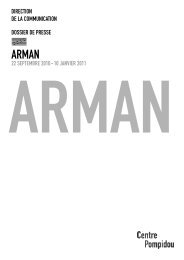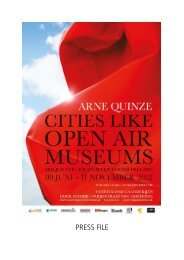Arman - Vicky David Gallery
Arman - Vicky David Gallery
Arman - Vicky David Gallery
Create successful ePaper yourself
Turn your PDF publications into a flip-book with our unique Google optimized e-Paper software.
�<br />
5<br />
2. PLAN & INTRODUCTION TO THE EXHIBITION<br />
This retrospective of more than 120 works, some of them of monumental scale, has been organized around<br />
seven themes. <strong>Arman</strong>’s work cannot in fact be understood in terms of successive periods. For he frequently<br />
returned to and revised the “procedures” of earlier times – accumulations, garbage cans, slicings, rages<br />
and combustions – creating a living language that developed with every discovery or invention.<br />
<strong>Arman</strong> loved objects, of that there can be no doubt. Yet he did not proceed by random or unstructured<br />
accumulation, but marshalled them in the mode of the drawer or pigeonhole, characteristic of the craftsman.<br />
He collected and he classified. <strong>Arman</strong> was passionate too about chess, and later about the game of<br />
Go. While the first involves the capture or neutralization of the opponent’s most important pieces, Go<br />
�<br />
requires the strategic mastery of a territory defined by a squared grid. This �<br />
observation has led us to think<br />
that the square or box (very evident in the Accumulations of collections for example) may be a key notion<br />
for the understanding of “<strong>Arman</strong>ian territory.”<br />
�<br />
ENTRANCE<br />
� La Victoire de Salemotrice, Accumulation Renault n°101, 1967<br />
ROOM 1: FROM THE INFORMAL TO THE OBJECT<br />
The first Cachets (rubber-stamp works) and Allures d’objet (Gait of the Object works) introduce the principle<br />
of accumulation into <strong>Arman</strong>’s work, gradually legitimizing the presence of the object in the painted surface.<br />
� Allure d'objets II, 1959<br />
ROOM 2: POUBELLES AND LE PLEIN<br />
The first Poubelles (garbage cans), the Portraits-robots, the exhibition “Le Plein” (1960), the Organic<br />
Garbage Cans, the Grand Plein newyorkais (1972).<br />
ROOM 3: THE CRITICAL MASS OF THE OBJECT<br />
“A thousand droppers are more dropper than a single dropper.” <strong>Arman</strong><br />
The object is grasped in its seriality: multiple, identical and always different. Compressed into a given<br />
volume, bereft of any poetic or aesthetic context, the accumulation is conceived as a portion of the real.<br />
� Home sweet home, 1960<br />
ROOM 4: COLÈRES AND COUPES<br />
In 1961, <strong>Arman</strong> made his first Colères (Rages) physical performances inspired by the spirit of the martial<br />
arts in which the artist transformed a found object or readymade by breaking it apart. The Coupe [Slicing]<br />
is a cooler and more reflective procedure whereby the object itself can be made to undergo anamorphosis.<br />
Included here are <strong>Arman</strong>’s first “explosion,” Die Wise Orchid (1963) – what remains of an MG sports car<br />
after a spectacular performance at Essen in Germany in 1963, never before shown in Paris; and also<br />
Conscious Vandalism, an environment resulting from a performance at the John Gibson <strong>Gallery</strong> in New York<br />
in 1975.<br />
�<br />
�




